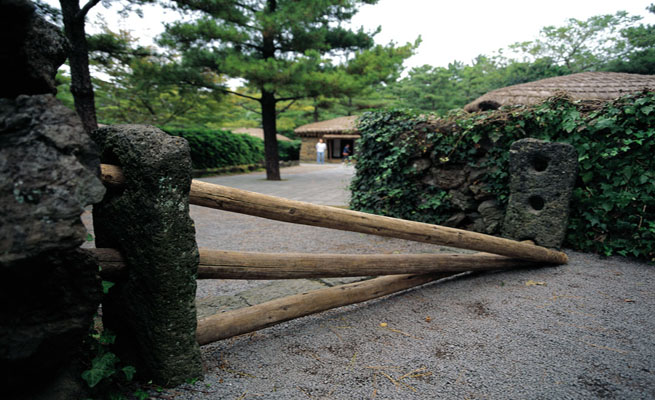‘Plentys’ and ‘lacks’ pervade Jeju culture

While Jeju provides many things to see and do, it is traditionally known for a plentitude of three things, and a shortage of three others.
“Samda” means “three plentys,” and refers to the abundance on Jeju of seokda (rocks), pungda (wind) and yeoda (women).
“Sammu” means “three lacks,” and refers to the absence of thieves, beggars and gates.
While the translations to English are not exact, the sentiments reflect Jeju’s culture and environment very well.
The three plentys
Jeju is essentially one big volcanic rock, and the stones are everywhere. Farmers over the centuries have dug the angular lava rock boulders from the land and turned them into fences. The result looks very much like rural Ireland, with low stone walls surrounding richly tilled fields, often accompanied by a stone cottage.
Larger rocks are carved into pock-marked Grandfather Stones, the ubiquitous dolhrabang that is unique to Jeju, or other fantastic statuary.
The rocky skeleton of Jeju can be seen dramatically jutting out into the sea in many places, like lave frozen in time. It is a reminder of a prehistoric time when Hallasan was an active volcano, rather than a photogenic backdrop.
The stone walls also protect against the second “many,” wind. Anyone who comes to Jeju by air or sea has experienced the winds that flow across the island that is located in the path of typhoons.
The effect of living with the constant wind can be seen in the traditional style of Jeju homes, with hand-twisted straw rope laced across thatch roofs to hold them in place. It can also be observed in the graceful, twisted shape of pine trees along the coast.
The abundance of women is a statistical fact that was caused by many Jeju men losing their lives at sea while fishing. Jeju women, including the famous diving haenyeo, came to be known for their strength and independence.
With the men gone to sea they learned to tend the fields as well as gather food from the shore and sea. And, a woman’s work is never done – they also did the housekeeping, cooking and childcare duties.
The three lacks
While these three natural abundances have shaped Jeju’s physical appearance, the three lacks have shaped its moral character.
“Sammu” denotes the strong will of the Jeju people, who have endured a harsh environment and a terrible history.
“No thieves” underlies the desire for a just society on Jeju, with justice for all. The people of Jeju have suffered in the past under occupying forces and under the hand of the Korean government. But they have moved beyond those dark times, and pride themselves on being simple and honest. Behind this strong philosophy is said to be a firm spirit, which rejects the temptation to turn to acts of revenge.
One of the things visitors to Jeju often comment on is the lack of beggars or vagrants on the streets. This is exemplified in the “no beggars,” sentiment, as Jeju people pride themselves on being self-reliant, diligent and frugal.
The strong commitment to family also means less fortunate members have somewhere to turn in times of need.
Traditional Jeju houses don’t have sturdy gates, but simply three poles stretched between stone gateposts. They serve more to keep livestock in than to keep visitors in.
This is the “no gates” philosophy, which indicates a spirit of a mutual confidence, cooperation and love of one’s neighbors.
While in these modern times the city dwellers in Jeju do have gates, and sometimes bars as well, the spirit of openness and welcome still pervades the island; the spirit of Sammu.
| Marcie Miller/Managing Editor Archives ⓒ Jeju Weekly 2009 (http://www.jejuweekly.com) All materials on this site are protected under the Korean Copyright Law and may not be reproduced, distributed, transmitted, displayed, published without the prior consent of Jeju Weekly. |

